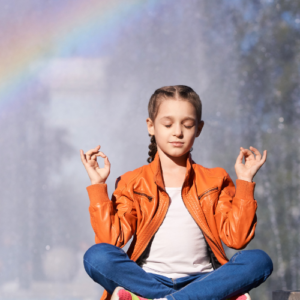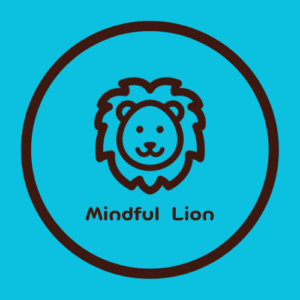F i n n c h
Mindful Lions Program
- Home
- Mindfulness activities
Mindfulness for kids – four easy mindfulness exercises for children



Mindfulness for children – the benefits of mindfulness therapy
Mindfulness has many health benefits for adults, including reduced stress, less rumination (mulling over your thoughts), and improved focus, working memory, and flexibility of thinking.
Mindfulness for children hasn’t been as well researched. However, a growing body of evidence supports mindfulness-based therapy for kids. Some benefits that have been supported by studies include:
- Improved attention, focus, and cognitive development
- Enhanced social and emotional skills, such as greater empathy
- Improved behaviour at school
- Increased resilience
- Improved emotional regulation
- Reduced anxiety and stress.
Mindfulness meditation for kids can help them learn to calm their bodies and minds. This creates a relaxed, positive environment, which can benefit behavior, communication, and emotional regulation.
It can help children learn patience and explore feelings such as gratitude and love.
Mindfulness exercises can be used throughout a child’s daily routines (such as taking deep breaths to calm down) or be a planned relaxation experience (such as meditation or yoga). Mindfulness training helps to calm the mind and body and assists in being present in the moment. This supports children to be in control and fosters positive interactions and relationships.
Mindfulness exercises for kids
Listening walk
A listening walk is simply going for a walk with your child, focusing on your surroundings, and sharing your findings. Familiar places are great because your child can discover things they haven’t noticed before. A listening walk helps teach your child patience and how to be present in the moment.
How to do a mindful listening walk:
- Ask your child where they would like to walk. Places such as a garden or beach are great as they have natural sounds like leaves rustling or waves crashing
- Ask your child what sounds they expect to hear and why
- Stop often, close your eyes, and encourage your child to listen. After a minute or two, ask your child what sounds they heard and why they think they heard them.
Remember to keep it FUN and let your child take the lead! For younger children, adapt the mindful listening walk by seeing if they can make each noise they heard or locate where the sound came from.
Mindful Posing
An easy way for children to dip their toes into mindfulness is through body poses. To get your kids excited, tell them doing fun poses can help them feel strong, brave, and happy.
Have the kids go somewhere quiet and familiar—a place they feel safe. Next, ask them to try one of the following poses:
- The Superman: stands with the feet just wider than the hips, fists clenched, and arms reached out to the sky, stretching the body as tall as possible.
- The Wonder Woman: Stand tall with legs wider than hip-width apart and hands or fists placed on the hips.
Ask your kids how they feel after a few rounds of trying these poses. You may be surprised!
Mindful glitter jar or ‘calm jar’
This activity can teach children how strong emotions may take hold, and how to find peace when emotions feel overwhelming.
- First, you’ll need to make a sparkly calm jar. It’s simple – get a clear jar or bottle (like a Mason jar) and almost fill it with water. Add a big spoonful of glitter glue or glue and dry glitter to the jar. Put the lid on and shake the jar to make the glitter swirl.
- Use the following script (from Karen Young at Hey Sigmund) or take inspiration from it to create your own mini-lesson:
“Imagine that the glitter is like your thoughts when you’re stressed, mad or upset. See how they whirl around and make it really hard to see clearly? That’s why it’s so easy to make silly decisions when you’re upset – because you’re not thinking clearly. Don’t worry this is normal and it happens to all of us (yep, grownups too).”
Put the jar down in front of them.
“Now watch what happens when you’re still for a couple of moments. Keep watching. See how the glitter starts to settle and the water clears? Your mind works the same way. When you’re calm for a little while, your thoughts start to settle, and you start to see things much clearer. Deep breaths during this calming process can help us settle when we feel a lot of emotions.”
This exercise not only helps children learn about how their emotions can cloud their thoughts, it facilitates the practice of mindfulness while focusing on the swirling glitter in the jar.
Try having the kids focus on one emotion (such as anger) at a time and discuss how the shaken versus settling glitter is like that emotion.
Five senses exercise
This exercise makes practicing mindfulness easy in nearly any situation. All you need to do is notice something you’re experiencing with each of the five senses.
Follow this order:
- Notice five things you can see.
Look around you and bring your attention to five things you can see. Pick something you don’t normally notice, like a shadow or small crack in the concrete.
- Notice four things you can feel.
Bring awareness to four things you are currently feeling, like the texture of your pants, the feeling of the breeze on your skin, or the smooth surface of a table you’re resting your hands on.
- Notice three things you can hear.
Take a moment to listen and note three things you hear in the background. This can be the chirp of a bird, the hum of the refrigerator, or the faint sounds of traffic from a nearby road.
- Notice two things you can smell.
Bring your awareness to smells that you usually filter out, whether they’re pleasant or unpleasant. Perhaps the breeze is carrying a whiff of pine trees if you’re outside, or the smell of a fast food restaurant across the street.
- Notice one thing you can taste.
Focus on one thing you can taste right now, at this moment. You can take a sip of a drink or eat something, notice the current taste in your mouth, or even open your mouth to search the air for a taste.
This easy exercise can bring your child to a mindful state quickly.
================================================================================== Find out more about working with qualified, experienced psychologists and behavior support therapists by contacting Finnch Wellness on 224 244 5589 or SEND US AN EMAIL MESSAGE.
